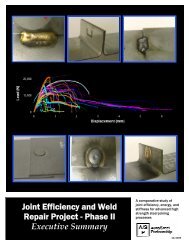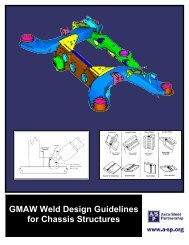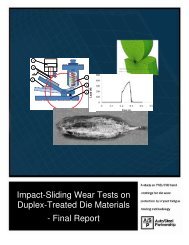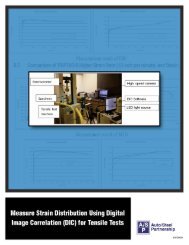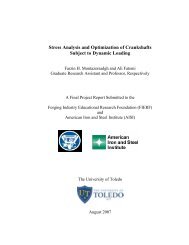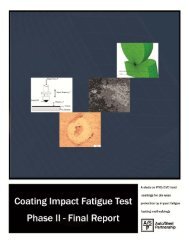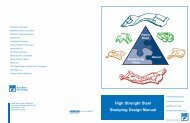Light Truck Frame Joint Stiffness Study Phase 1 Final Report
Light Truck Frame Joint Stiffness Study Phase 1 Final Report
Light Truck Frame Joint Stiffness Study Phase 1 Final Report
You also want an ePaper? Increase the reach of your titles
YUMPU automatically turns print PDFs into web optimized ePapers that Google loves.
APPENDIX A: ABSTRACTS<br />
Read Articles<br />
1. Experimental Studies and Design of Steel Tee Shear Connections<br />
Astaneh, Abolhassan,and Nader, Marwan N.<br />
Journal of Structural Engineering v 116 n 10 Oct 1990 p. 2882-2902 0733-9445 JSENDH 15<br />
A tee-framing shear connection consists of a steel tee section connected to a beam web and to a<br />
supporting member such as a column. The main role of the tee-framing shear connections is to<br />
transfer end shear reaction of simply supported beams to the supporting members. Usually, bolt<br />
groups or weld lines are used to connect the tee element to the beam web and to the support. An<br />
experimental investigation of the actual behavior of tee-framing shear connections is conducted by<br />
testing nine full-size beam-to-column-joint assemblies. The connections are subjected to realistic<br />
combinations of shear forces and rotations. The research establishes six failure modes for these<br />
connections. The studies indicate that the tee-framing connections tested are sufficiently flexible to be<br />
considered simple connections. A summary of the experimental research is presented. The<br />
experimental data and associated analytical studies are used to adapt mechanical models of the<br />
failures and to develop and propose new design procedures.<br />
2. A Numerical Approach to Define the Rotational <strong>Stiffness</strong> of a Prefabricated Connection and<br />
Experimental <strong>Study</strong>.<br />
Aydogan, M. and Akoz, A.Y.<br />
Computers & Structures, 1995<br />
A numerical approach is proposed to define the elastic rotational stiffness of a typical joint on the top<br />
beam of a prefabricated reinforced concrete gable frame structure. The 12 degrees of freedom<br />
triangular plane stress finite element is used to examine the connection region. Using this joint<br />
rotational stiffness value, realistic results are obtained in the frame analysis. The experimental<br />
verification is performed by means of the photoelastic method. Following the proposed method, an<br />
effective joint length with reduced moment of inertia is defined and using this concept the frame<br />
solution is simply achieved, including the existence of joint.<br />
3. Initial <strong>Stiffness</strong> of Semi-Rigid Steel Beam-to-Column Connections<br />
Azizinamini, J.; Bradburn, H.; and Radziminski, J. B.<br />
Journal of Constructional Steel Research; 1987<br />
Semi-rigid connections of the type studied in this investigation are distinguished by moment-rotation<br />
curves which become non-linear relatively early during static loading. However, the connections<br />
exhibited linear unloading behavior, a linearity that was retained as moment was reapplied, to a<br />
maximum approaching that imposed during the initial load application. The slope of this latter curve<br />
was found to be essentially the same as the initial slope of the moment-rotation curve during first<br />
loading. Thus, the initial slope is of direct significance from a design viewpoint, in that it can be used<br />
to represent the stiffness of the connection in the analysis of the complete structural system,<br />
particularly under live load fluctuations. In this paper, an analytical procedure is developed to predict<br />
the initial stiffness of a particular type of semi-rigid connection; the predicted slopes were found to<br />
compare favorably with experimentally determined connection behavior.<br />
<strong>Report</strong>: A/SP-005-1 <strong>Light</strong> <strong>Truck</strong> <strong>Frame</strong> <strong>Joint</strong> <strong>Study</strong> 70



